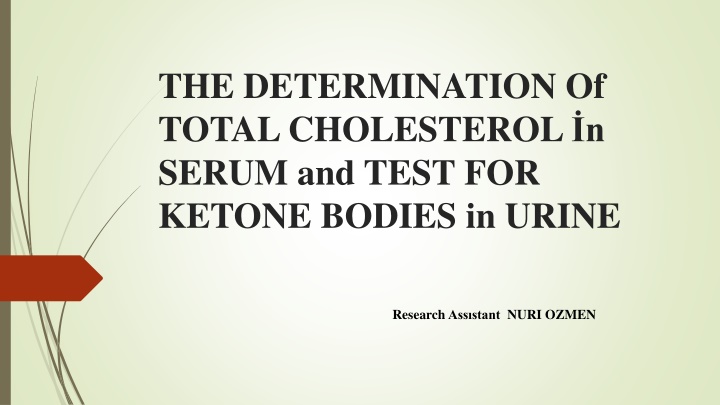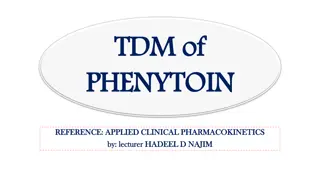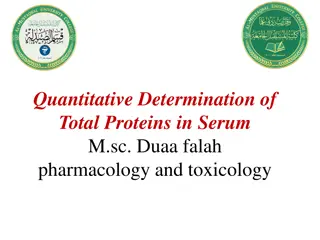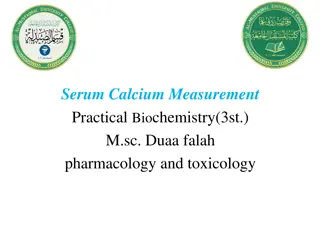
Cholesterol and Ketone Bodies in Serum and Urine
Explore the determination of total cholesterol in serum and the testing for ketone bodies in urine. Learn about cholesterol synthesis, normal values, methods like the ZAK method, and the role of ketone bodies in energy metabolism.
Download Presentation

Please find below an Image/Link to download the presentation.
The content on the website is provided AS IS for your information and personal use only. It may not be sold, licensed, or shared on other websites without obtaining consent from the author. If you encounter any issues during the download, it is possible that the publisher has removed the file from their server.
You are allowed to download the files provided on this website for personal or commercial use, subject to the condition that they are used lawfully. All files are the property of their respective owners.
The content on the website is provided AS IS for your information and personal use only. It may not be sold, licensed, or shared on other websites without obtaining consent from the author.
E N D
Presentation Transcript
THE DETERMINATION Of TOTAL CHOLESTEROL n SERUM and TEST FOR KETONE BODIES in URINE Research Ass stant NURI OZMEN
75% of the cholesterol in circulation is esterified with fatty acids, the rest as free cholesterol. In organism, cholesterol is synthesized in many tissues except erythrocyte, but the tissue from which it is synthesized is liver (about 80%).
Normal Total Cholesterol Values: 110-250 % mg Hypercholesterolemia occurs when cholesterol increases in blood: infectious hepatitis and portal cirrhosis, Nephritis, Pancreatic diseases, Hypothyroid and myxedema, Xanthomatosis Hypocholesterolemia occurs as a result of the decrease of cholesterol in the blood: Hyperthyroidism Increased lipolysis with the effect of estrogen hormone
ZAK METHOD Principle: Based on the red-violet colour which is proportional to the amount of cholesterol and formed after the reaction of cholesterol melted in acetic acid,FeCl3 and sulfuric acid. Cholesterol in glacial acetic acid gives a red colour with ferric chloride and apolar sulphuric acid. This reaction has been employed by ZAK S to estimate the cholesterol in an unknown serum sample. Material: Serum Experimental procedure: 1. For the preparing serum filtrate, n a centrifuge tube, add 0.4 ml of serum, 4 ml of iron chloride chloride and stir. 2. This solution is read at 560 nm in the spectrophotometer. Using the standard curve graph, the amount of cholesterol in the serum is evaluated as % mg.
Preparation of Standard Curve Graph Blank TUBE 1 TUBE 2 TUBE 3 TUBE 4 Sample - 0.25 mL 0.5mL 1mL 1.5mL - Cholesterol standart solution (%10mg) FeCl3indicator 2mL 2mL 2mL 2mL 2mL - Serum filtrate - - - - - 2mL Sulfuric acid 2mL 2mL 2mL 2mL 2mL 2mL Glacial acetic acid 2mL 1.75 ml 1.5mL 1mL 0.5mL 2mL 0 51.25 102.5 205 307.5 - % mg of cholesterol in serum
Standart Graphic Normal Total Cholesterol Values for Zak method= 110-250 mg %
KETON BODIES The main sources of energy are broken down to acetyl CoA as a result of metabolism. Acetyl CoA enters the crepe cycle to observe energy. Cholesterol synthesis plays a role in the synthesis of fatty acids, A number of acetyl CoA is converted to ketone bodies through a series of reactions (ketogenesis). Ketone bodies: Acetoacetic acid B-hydroxy butyric acid Acetone
In the organism, ketone bodies accumulate, this is called ketosis. Ketosis increases the ketone bodies in the blood. Increasing the concentration of ketone bodies in the blood is called ketoneemia or hyperketonemia. Ketone bodies that increase in blood flow into the urine. This is called ketonuria. Accumulation of ketone bodies in the blood causes a condition called acidosis.
Ketosis is seen in pathological and physiological conditions: Diabetes, Diet (high fat , low carbohydrate dietary) Pregnancy
TESTS for KETONE BODIES in URINE LANGE TEST (for acetone): Principle: Sodium nitroprussiate is formed a colored complex with acetone. Material: Urine Experimental procedure 1. 2 ml of urine is collected in tube and then 0.5 ml of glacial acetic acid and 0.5 ml of 10% sodium nitroprusside solution is added. 2. The tube is kept in an inclined state and 2 ml of ammonium hydroxide is added to bring a layer to the plate 3. Purple ring formation between the two liquids indicates the presence of acetone.
TESTS for KETONE BODIES in URINE GERHARD TEST (for acetoacetic acid ): Principle: Acetoacetic acid is formed red color with iron chloride 3 chloride Material: Urine Experimental procedure: 1. 2 mL of urine is collected into a test tube. A few drops of 10% FeCl3are added. The formation of cherry or reddish red color indicates the presence of acetoacetic acid in urine.
References Biochemistry pratice book (2004)






















